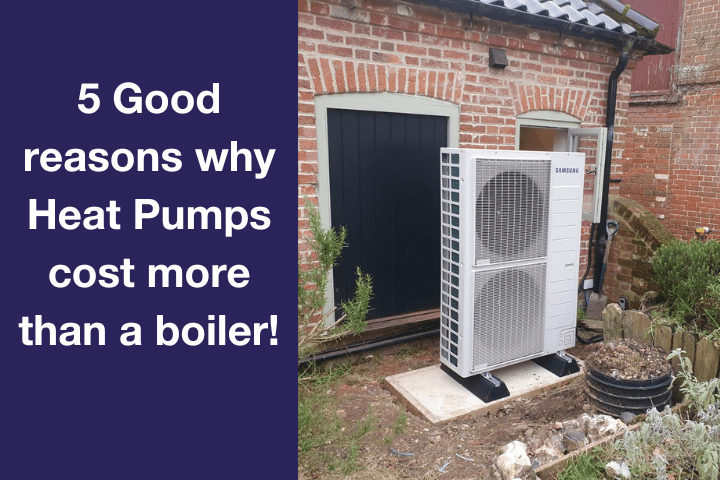Ground Source Heat Pumps: 10 Benefits and other amazing facts to know
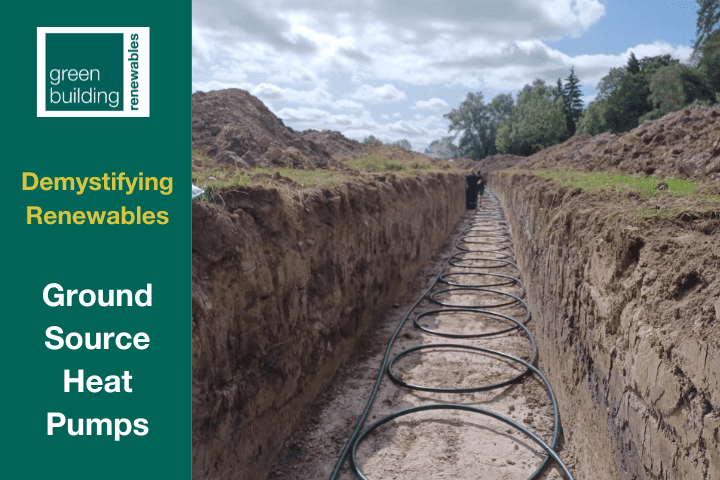
A ground source heat pump (GSHP), sometimes called a ground-to-water heat pump, transfers heat from the ground outside your home to heat your home via your radiators or, if you have it, underfloor heating. The heat can also heat water stored in a hot water cylinder for your shower, bath and taps.
Ground Source Heat Pumps can also be installed within water sources such as ponds and lakes.
We get asked lots of questions about ground source heat pumps. How do they work? How does the type of ground affect how they work? How easy are they to install? The questions we get are varied and in this blog, we will try and answer as many as we can.
Table of Contents
Understanding Ground Source Heat Pumps
How do Ground Source Heat Pumps Work?
Ground source heat pumps use the Earth’s geothermal energy. They exploit the relatively stable temperature beneath our feet (or in your back garden) for heating purposes.
In contrast to air-source heat pumps (ASHPs), which rely on temperature fluctuations in the air, ground source heat pumps take advantage of the more consistent temperature found underground.
Open Loop Systems vs Closed Loop Systems
There are two main types of GSHP. An open loop system and a closed loop system. An open loop system consists of a pipe buried beneath the ground and which uses nearby groundwater for heat exchange. The water does not circulate but instead is directed into drainage after use. In contrast, a closed loop system circulates a mixture of anti-freeze and water.
Closed-loop systems are the most commonly used type of ground source heat pumps. However, there are advantages to the open loop system.
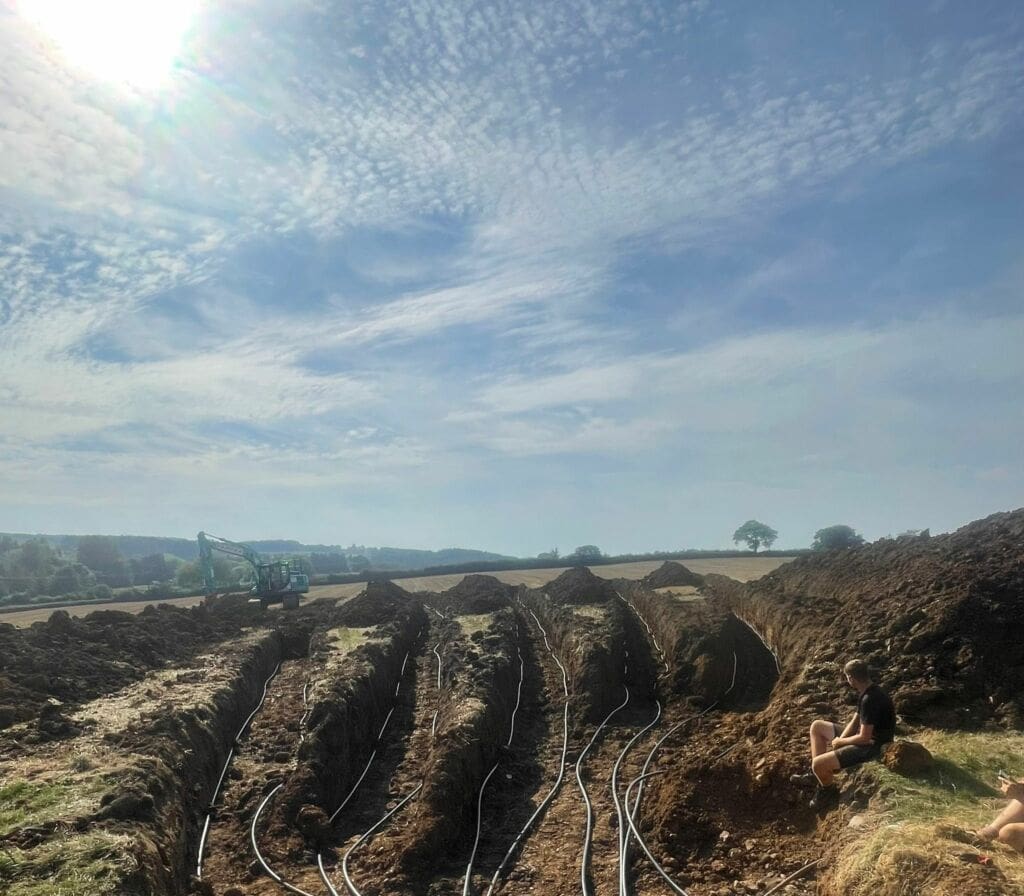
Open Loop systems generally have lower installation costs. In general, it has a more straightforward design and lower implementation costs, which make it an overall less expensive option than a closed-loop system.
Also, an open loop system only requires a borehole to pump water from an aquifer below the ground. In contrast, a closed-loop system requires a grid of pipes. Therefore, an open loop system can be a better option where space is limited. In an open loop system, the groundwater heat is directly extracted. In a closed loop system, heat from the ground is transferred to a working fluid, reducing the efficiency and increasing the area needed and intricacy of the ground heat exchanger.
But how do Ground Source Heat Pumps Really Work?
You want a more technical answer about how ground source heat pumps work. That’s fair. They are a fantastic piece of technology. To understand more about the ‘nuts and bolts ’ of ground source heat pumps, it’s worth considering what the critical components of the technology are.
What are the key components of a ground source heat pump?
The essential components of a ground source heat pump system are:
Ground Loop:
This is the system of pipes which is buried in the ground. The loop can either be a long or coiled pipe buried horizontally in trenches or a long loop (called a probe) inserted vertically through boreholes with a diameter of around 180 mm. The ground loop contains the Thermal Transfer Fluid (TTF).
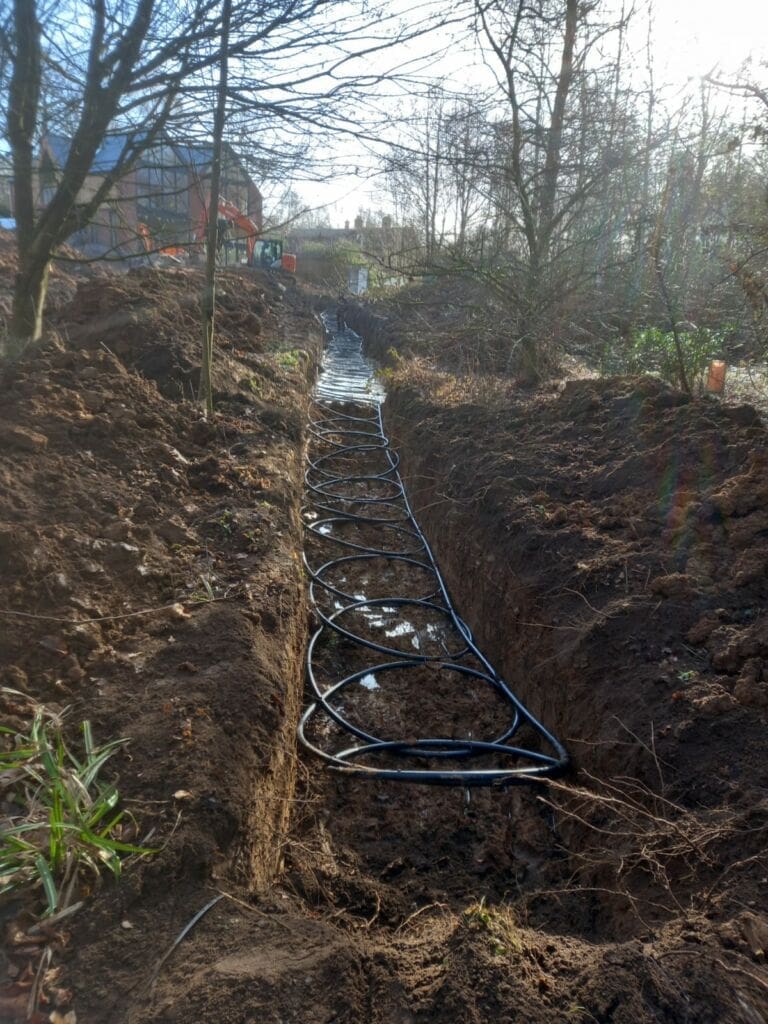
Thermal Transfer Fluid (TFF)
This mixture of water and antifreeze (glycol), sometimes called ‘brine’, flows around the loop buried in your garden or outdoor space. The heat from the ground is absorbed into this fluid. The TFF is continuously warmed up by the constant temperature of the ground. This is then passed through a heat exchanger into the ground source heat pump unit.
Heat Pump Unit
The heat pump (unlike an air source heat pump) is typically located inside your building. It contains a refrigerant loop connected to the outside heat exchanger, the compressor and the indoor heat exchanger, which is connected to the distribution system and expansion valve. The gas is fed into a compressor, and the compressing process increases the gas’s temperature. This is then fed to a heat exchanger, where it is distributed to the wet central heating system of the house, such as radiators, showers, faucets, and underfloor heating.
Distribution System
In the UK, most homes in the UK use radiators or underfloor heating to circulate hot water and distribute heat, which is known as a ‘wet system’. In the UK, ground source heat pumps need a wet system. If your house doesn’t have a wet system, you must decide whether to install one. This is a great opportunity to optimise the wet system for a heat pump, resulting in lower running costs.
What are the steps involved in how a ground source heat pump works?
The operation of a ground source heat pump, therefore, involves three main steps:
- Heat Absorption: In heating mode, the liquid in the ground loop absorbs the heat from the ground. This low-grade heat is then pumped into the heat pump unit.
- Heat Pump Process: The heat pump raises the temperature of the absorbed heat, making it suitable for space heating. This process is powered by electricity.
- Distribution: The heated water is distributed throughout the building to provide warmth.
A ground source heat pump can also be used to cool. However, in the UK, most people don’t install a cooling system because the extra cost of the additional valves, pumps and lagging all the pipework to avoid condensation isn’t worth it for how often it might be required in the UK.
Here’s a great video from Kensa, one of our suppliers, about ground-source heat pumps, which explains how they work.
How do the type of ground and the depth of the ground loop affect the efficiency of a ground source heat pump?
The efficiency of a ground source heat pump is influenced by the depth at which the ground loop is installed and the type of ground or soil it interacts with.
Generally, once you reach about 1 metre under the surface, the ground temperature stays fairly constant all year round – meaning ground source heat pumps can be used at any time of the year.
In more detailed terms, temperature does vary with the depth of soil. As you go deeper into the ground, especially with a vertical loop, the temperature remains more stable, experiencing minimal fluctuations due to seasonal changes. In the UK, the ground temperature (a few metres below our feet) is constantly around 8-11°C. We would never recommend a horizontal loop below 1m depth as the cost of digging and supporting such trenches would be very high.
When it comes to vertical loop systems and boreholes, this is how the temperature of the ground varies:
- Shallow Depth (3- 10 metres): The temperature becomes more stable below the surface, with less influence from seasonal changes.
- Moderate Depth (10-30 metres): The ground temperature in this range tends to be closer to the average annual air temperature.
- Deep Depth (30 metres and beyond): Vertical ground loops, which can reach significant depths, tap into the most stable temperatures. At depths exceeding 30 metres, the temperature remains relatively constant throughout the year.
Understanding the temperature profile of the ground at different depths is essential for optimising the design and performance of ground source heat pump systems.
Depending on the three depth profiles, there are three main types of ground source heat pump systems. They are:
- Shallow Horizontal Systems: In shallow installations, typically around 1- 2 metres deep, the ground temperature experiences more seasonal variations. While this can affect the system’s efficiency somewhat, these installations are often more cost-effective and easier to implement.
- Deep Horizontal Systems: Going deeper, up to about 3 metres, will provide a more stable temperature all year round. This increased stability can enhance the system’s efficiency but will involve much higher installation costs.
- Vertical Systems: Vertical installations are where boreholes are drilled deep into the ground. These offer the most stable temperatures. These systems can reach depths of 60m to 200 metres deep. But they depend significantly on the geological conditions of the land. Drilling is more complex and expensive; however, vertical ground source heat pumps can deliver high efficiency.
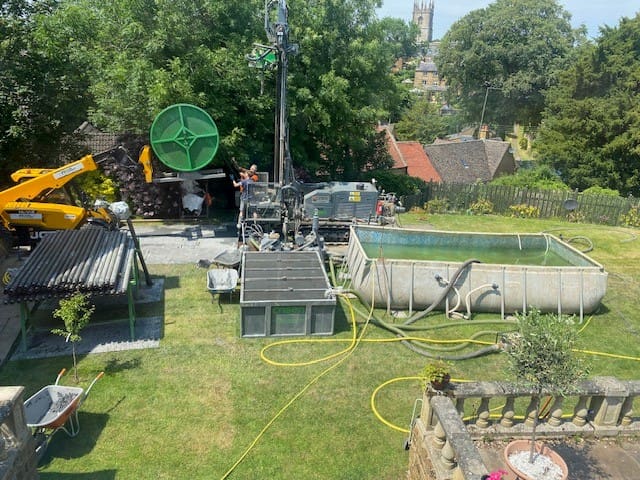
What about the types of soil? How can these affect ground source heat pumps?
The composition of soil can vary greatly, which can impact the soil’s thermal conductivity. Depending on the soil’s organic material and underlying geological make-up, its thermal properties will differ.
The thermal properties of soil in the UK vary a lot by region; therefore, to get an accurate efficiency estimation, you should always assess your home or property by an expert. But broadly speaking, when it comes to ground source heat pumps, there are two main types of soil to consider:
- Conductive Soils: Ground source heat pumps work most efficiently in soils with good thermal conductivity, meaning they can transfer heat effectively. Sandy soils and certain types of rock are examples of conductive soils.
- Less Conductive Soils: Clay and loamy soils have lower thermal conductivity, which can decrease the system’s efficiency. In such cases, larger or deeper ground loops may be necessary to compensate for the reduced heat transfer.
Understanding the specific geological conditions at a site is crucial for designing an optimal ground source heat pump system.
I want a ground source heat pump; what must I consider for my home?
Ground source heat pumps and their installation can seem very daunting. You might think your beautiful garden lawn will get ruined or the greenhouse will have to go, but believe it or not you don’t necessarily need a large space, especially if considering a vertical loop system.
Compared to an air source heat pump, a ground source heat pump system will have more impact on your home, and you will need land near your home suitable for digging trenches or drilling boreholes.
For the ground loop, the ground will need to be suitable for digging and accessible to machinery from a road entrance. Trees and their roots can cause problems when digging trenches, so they are best avoided. The length of the ground loop and trenches will depend on your home’s size and heating requirements.
For the average home’s system, you need between 600m2 to 1200m2 of clear land. It’s good to note that you’d also need trenches at least 100m long for most horizontal systems.
Space can be saved by creating circular loops, often called ‘slinkies’. Circular loop systems require less digging as the trenches are broader and shorter.
If the ‘horizontal space’ is limited, it may be possible to drill vertical boreholes instead. This is more expensive than digging trenches and usually needs a specialist ground (thermogeological) survey to be conducted. Large houses may require more than one borehole. The depth will depend on how much heat is required but can be anywhere between 60 to 200m deep.
The number of boreholes depends on the system size and soil type. But typically, an 8kW ground source heat pump system would require approximately three boreholes with a depth between 70m to 120m.
As well as the components installed outside your home, you will need space inside your home for the indoor heat pump unit. If you are building a new home, you could have a designated plant room. For existing homes, you may have space in a garage or outbuilding. The internal unit that often contains the hot water cylinder is roughly the size of a fridge freezer.
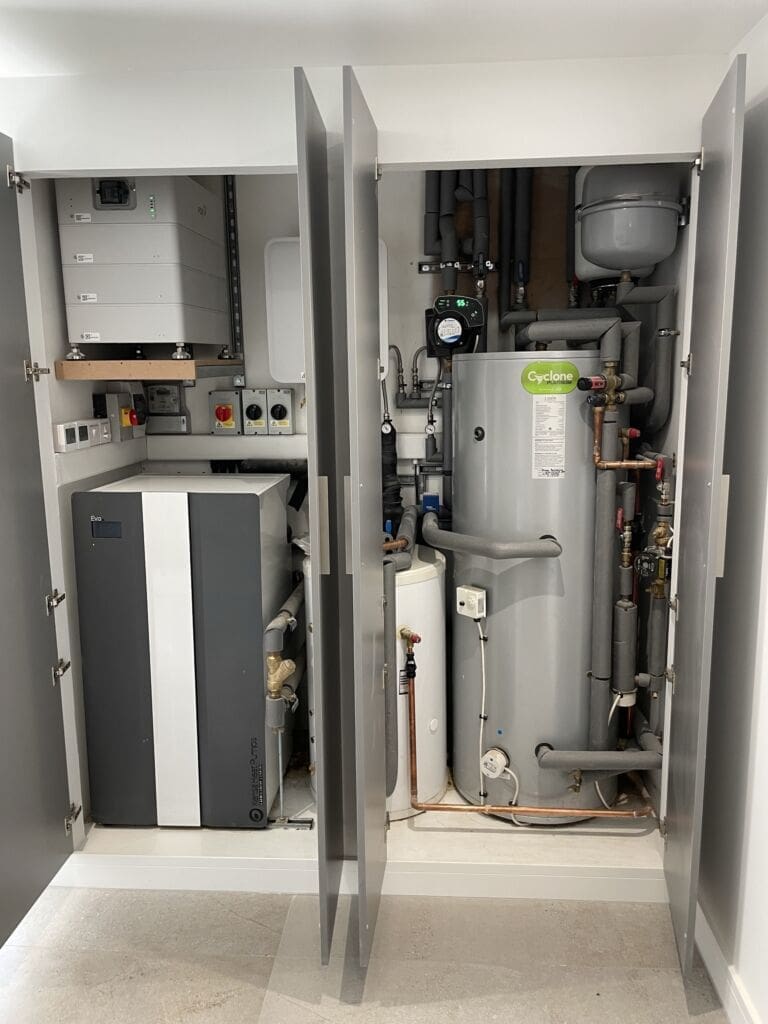
Why choose a ground source heat pump, what are the benefits?
Ground source heat pumps are the most efficient way to heat your home and are particularly beneficial to those homes that exist off the mains gas network and use Oil or LPG heaters instead.
As we have seen in the last few years, fossil fuel prices can fluctuate significantly, and they are far more likely to increase than they are to reduce. On average, when you replace a fossil fuel heater like an oil or LPG boiler with a heat pump, you can expect significant savings on your energy bills.
At the same time, the Government is offering generous incentives to homeowners who want to install heat pumps. The Boiler Upgrade Scheme currently offers £7,500 towards the installation costs of a ground source heat pump.
Here are ten benefits of Ground Source Heat Pumps.
1 – High Energy Efficiency:
Ground source heat pumps are known for their high efficiency. They can provide up to four units of heating (some are now as high as 5 units) for every unit of electricity used to power the system.
You may hear them described as being 400% efficient. This means for every kilowatt (kW) of electricity consumed by the heat pump, around 3-4 kilowatts of heat is generated in return. This can also be described as having a coefficient of performance (COP) of 3.5 to 4.5.
The ground’s stable temperature allows for consistent and efficient operation throughout the year. In contrast, air source heat pump efficiency is impacted by fluctuations in air temperature.
2 – Lower Operating Costs:
There’s no denying it: installing a ground source heat pump can be expensive due in no small part to the amount of labour needed when compared to the installation of a traditional heating system. However, over the life of the ground source heat pump, the lower operating costs can result in significant savings.
The efficiency of ground source heat pumps often leads to reduced energy consumption, translating to lower utility bills.
3. Environmentally Friendly:
Ground source heat pumps use the Earth’s renewable energy stored in the ground, producing fewer greenhouse gas emissions than traditional heating and cooling systems, especially when replacing oil or LPG heating systems.
The systems have minimal impact on the environment, as they do not rely on combustion and use a closed loop system for heat exchange.
4. Long Lifespan:
A ground source heat pump system can operate efficiently for 20 to 25 years or more with good maintenance.
The ground loop components, buried underground, are particularly durable, and the heat pump units are designed for extended use.
5. Stable and Consistent Performance:
Unlike air source heat pumps, which can be affected by outdoor temperature fluctuations, GSHPs benefit from the ground’s stable temperature. This stability ensures consistent performance, regardless of external weather conditions.
6 – Versatility:
Ground source heat pumps can be used for heating and cooling, providing year-round comfort in residential, commercial, and industrial settings.
The systems can also be integrated with other heating and cooling technologies to create hybrid systems that maximise efficiency.
7 – Reduced Dependence on Fossil Fuels:
By harnessing the Earth’s natural thermal energy, they help contribute to reducing dependence on fossil fuels for heating and cooling.
8 – Low Maintenance Requirements:
As previously mentioned, GSHPs generally have lower maintenance requirements than traditional heating and cooling systems. The ground loop, once installed, is often maintenance-free, and the heat pump units require routine check-ups just like any heating system.
9 – Quiet Operation:
Ground source heat pumps operate quietly, both indoors and outdoors.
10 – Incentives and Rebates:
Currently, the Boiler Upgrade Scheme offers £7,500 towards eligible installations in the UK.
Do you need planning permission for a ground source heat pump?
If you are convinced that you want a ground source heat pump, one of the most common questions we ask is whether you need planning permission.
For most cases, you won’t need special planning permission to install a ground source heat pump, as it’s considered a permitted development. In England, permissions depend on your location and property size.
You will need planning permission if you’re installing more than one ground source heat pump, live in a listed building or a conservation area. Nonetheless, a good heat pump installer should be familiar with the regulations of your local area and can advise you. Our regional teams will know what’s best for your area.
So, how long does it take to install a ground source heat pump?
Once you have permission, if needed and after all the initial assessments and surveys are done. The groundwork and laying of an entire ground source heating system can take up to a week. The heat pump unit itself can be installed within two to three days but it is the piping in the ground and digging the trenches or boreholes, which can be more complex, and where the most significant surprises can take place. Who knows if you have an archaeological gem in your back garden?
With no hidden Roman ruins or Saxon gold, it should usually take about a week, depending on geological conditions and the weather. Finally, the heat pump device must be installed and connected to your heat distribution infrastructure.
The big question is, how much does a ground source heat pump cost?
Whether it is at shows, exhibits or on the phone, how much does a ground source heat pump cost? Is the most obvious question to ask.
Ground-source heat pumps are more expensive than air source heat pumps and, when compared to the cost of a new gas boiler, seem a lot more expensive. The upfront costs can seem daunting, but it is worth remembering that savings, better efficiency, the lifespan of the system and low maintenance needs can compensate for the costs.
When asked this question, we often say the same thing. It depends. A frustrating answer to hear, but without a survey and assessment of your energy needs, it’s the best answer.
The price of a ground source heat pump does depend on several factors that vary from home to home. They are:
- Complexity of the job
- The size and type of system chosen, e.g. horizontal vs vertical
- The amount of labour. Drilling requires specialist equipment.
- If changes are needed to the existing heating distribution system. For example, do you need new radiators or a new underfloor heating system?
Our team will ensure that we provide you with the most accurate estimate of cost possible based on what you require. Get in touch today with your local office today.


